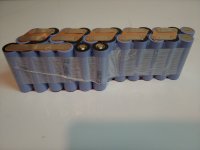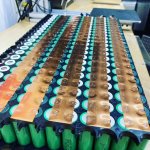Hummina Shadeeba
10 MW
BobBob said:With a crimp the wire is supported at the ends and bending limited so the flex occurs in the loop.
1. With one or more strips, the mechanical fixing is via a tiny spot weld with perhaps 1% of the cross section of the strip so most of the strain may occur there.
i can glue the strip where it contacts the cells to help there
2. The flex and vibration are likely to introduce strain other than rotating around an axis through the centre of your looped strip. The strip will not bend as well if the cells move side to side or if the strp vibrates weirdly.
stress in other directions i think youre right and will put a lot of strain on connections...all i could do is glue the strip where it holds to the cell for more holding power. but the scenario under a skate deck velcroed in place should limit it to bending in the one direction.
3. The coiled coil high flex cable configuration means that the strand path is a tight helix following a more gently helix in the opposite direction following the path of the wire, supported by lots of other strands and all supported by insulation. imagine bending a slinky backward and forward until it snaps - you'd be there a while. Now imagine it was a straight piece of slinky wire - much more bend per wire section thus strain so if fails sooner.
The engineering complexity is way greater compared to that of the physics of bending a theoretical part and 3d.
im not seeing great engineering complexity and think the angle the material is bent decides how much stress it gets. the helix helps lower the angle any part of the material is bent as the bend is distributed, like a slinky as you say, but inside a wire isnt as wound as a slinky and often multistrand isnt wound at all so i dont think it's that important.
Bit of wire from an old robot cable I designed 20 yrs ago.
The previous chap used high flex but not for mobile (easy to bend once) and the strands had migrated through the insulation in a rolling loop and shorted to each other intermittently dependent on robot position (worldwide and intermittent)
Twisted twists.jpg
just as i see it. im no expert on wire but going with the simple understanding, which may not even be true, that the thickness of the material and how far it's bent and how many times decides if it will break




